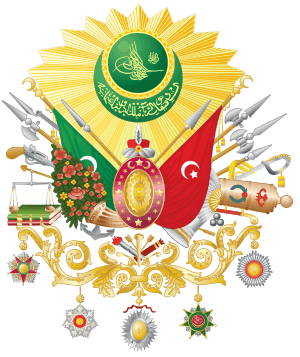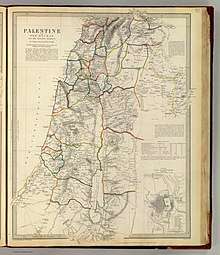Gaza Sanjak
Gaza Sanjak (Turkish: Gazze Sancağı) was a sanjak of the Damascus Eyalet, Ottoman Empire centered in Gaza. In the 16th century it was divided into nawahi (singular: nahiya; third-level subdivisions): Gaza in the south and Ramla in the north.[1]
| Gaza Sanjak Gazze Sancağı | |
|---|---|
| sanjak of the Ottoman Empire | |
| 1516–1916 | |
 Coat of arms
| |
 | |
| Capital | Gaza |
| History | |
| 1516 | |
• Sykes–Picot Agreement | 16 May 1916 1916 |
List of settlements
In the 1596- daftar, the sanjak contained the following nahiyah and villages/town
Gaza Nahiyah
- Al-Sawafir al-Sharqiyya,[2] Bayt Tima,[2] Hamama,[2] Al-Tina,[3] Yibna,[3] Isdud,[3] Arab Suqrir,[3] Deir al-Balah,[4] Burayr,[4] Jabalia,[4] Beit Lahia,[4] Al-Majdal, Askalan,[4] Bayt 'Affa,[4] Najd,[4] Ni'ilya,[4] Bayt Jirja,[5] Hiribya,[5] Qatra,[5] Iraq Suwaydan,[5] Kawkaba,[5] Beit Jimal Monastery,[5] Al-Batani al-Sharqi,[5] Al-Qubayba,[6] Al-Faluja,[6] Bayt Daras,[6] Al-Maghar,[6] Hatta,[7] Jusayr,[7] Zikrin,[7] Zayta,[7] Barqa,[7] Beit Hanoun,[7] Dayr Sunayd,[7] Simsim,[7] Al-Jaladiyya,[8] 'Ajjur,[8] Al-Sawafir al-Gharbiyya,[9] Julis,[9] Karatiyya,[9] Bayt Jibrin,[9] Iraq al-Manshiyya,[9] Qastina,[9] Ibdis,[9] Idnibba,[10] Jilya,[10] Rafah,[10] Al-Jura,[10] Tell es-Safi,[10] Abasan al-Kabera,[10] Al-Sawafir al-Shamaliyya,[11] Summil,[11] Barbara,[11] Al-Muharraqa,[11] Mughallis,[11] Yasur[11]
Ramla Nahiyah
- Qula,[11] Dayr Tarif,[11] Jaffa,[11] Jimzu,[12] Kharruba,[12] Barfiliya,[12] Sarafand al-Amar,[12] Artuf,[12] Bayt Susin,[12] Islin,[12] Al-Khayriyya,[13] Khulda,[13] Al-Tira,[13] Dayr Ayyub,[13] Qibya,[13] Bayt Nabala,[13] Budrus,[13] Bnei Brak,[13] Imwas,[13] Aqir,[13] Deir Qaddis,[14] Yalo,[14] al-Midya,[14] Shuqba,[14] Salama,[14] Sar'a,[14] Saqiya,[14] Lod,[14] Jisr Jindas,[15] Bayt Dajan,[15] Al-Safiriyya,[15] Al-'Abbasiyya,[15] Yazur,[15] Innaba,[15] Rantiya,[15] Bir Ma'in,[15] Bayt Shanna,[15] Ni'lin,[15] Kharbatha Bani Harith,[15] Kasla,[15] Aboud,[16] Beit Sira,[16] Kafr 'Ana[16]
gollark: That sounds very boring.
gollark: I, for one, would like to live to 260.00003.
gollark: Which is a bad thing.
gollark: No, I don't really think so.
gollark: Utilitarianishly speaking, and assuming we could only do one language, python was probably the correct choice.
References
- Cohen, Amnon; Lewis, Bernard (1978). Population and Revenue in the Towns of Palestine in the Sixteenth Century. Princeton: Princeton University Press. p. 12.
- Hütteroth and Abdulfattah, 1977, p. 142
- Hütteroth and Abdulfattah, 1977, p. 143
- Hütteroth and Abdulfattah, 1977, p. 144
- Hütteroth and Abdulfattah, 1977, p. 145
- Hütteroth and Abdulfattah, 1977, p. 146
- Hütteroth and Abdulfattah, 1977, p. 147
- Hütteroth and Abdulfattah, 1977, p. 148
- Hütteroth and Abdulfattah, 1977, p. 149
- Hütteroth and Abdulfattah, 1977, p. 150
- Hütteroth and Abdulfattah, 1977, p. 151
- Hütteroth and Abdulfattah, 1977, p. 152
- Hütteroth and Abdulfattah, 1977, p. 153
- Hütteroth and Abdulfattah, 1977, p. 154
- Hütteroth and Abdulfattah, 1977, p. 155
- Hütteroth and Abdulfattah, 1977, p. 156
Bibliography
- Hütteroth, Wolf-Dieter; Abdulfattah, Kamal (1977). Historical Geography of Palestine, Transjordan and Southern Syria in the Late 16th Century. Erlanger Geographische Arbeiten, Sonderband 5. Erlangen, Germany: Vorstand der Fränkischen Geographischen Gesellschaft.
This article is issued from Wikipedia. The text is licensed under Creative Commons - Attribution - Sharealike. Additional terms may apply for the media files.